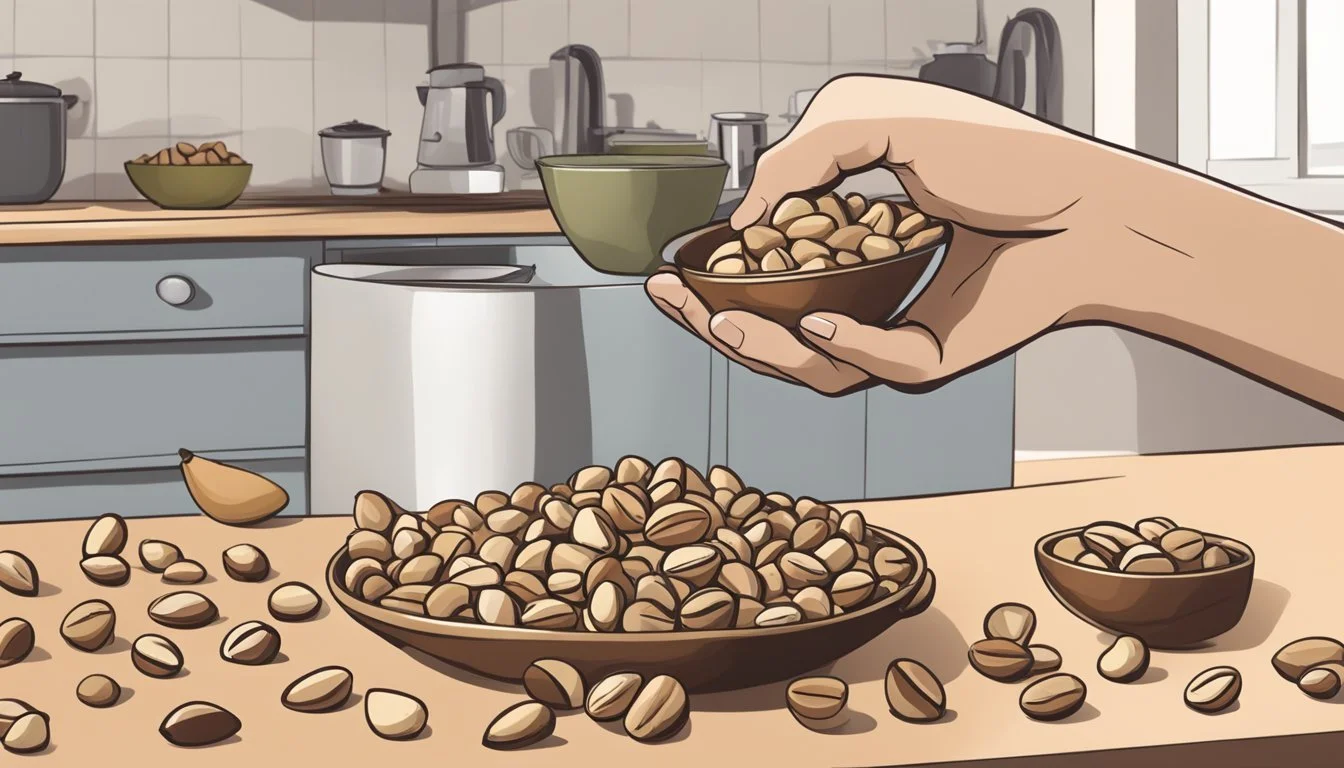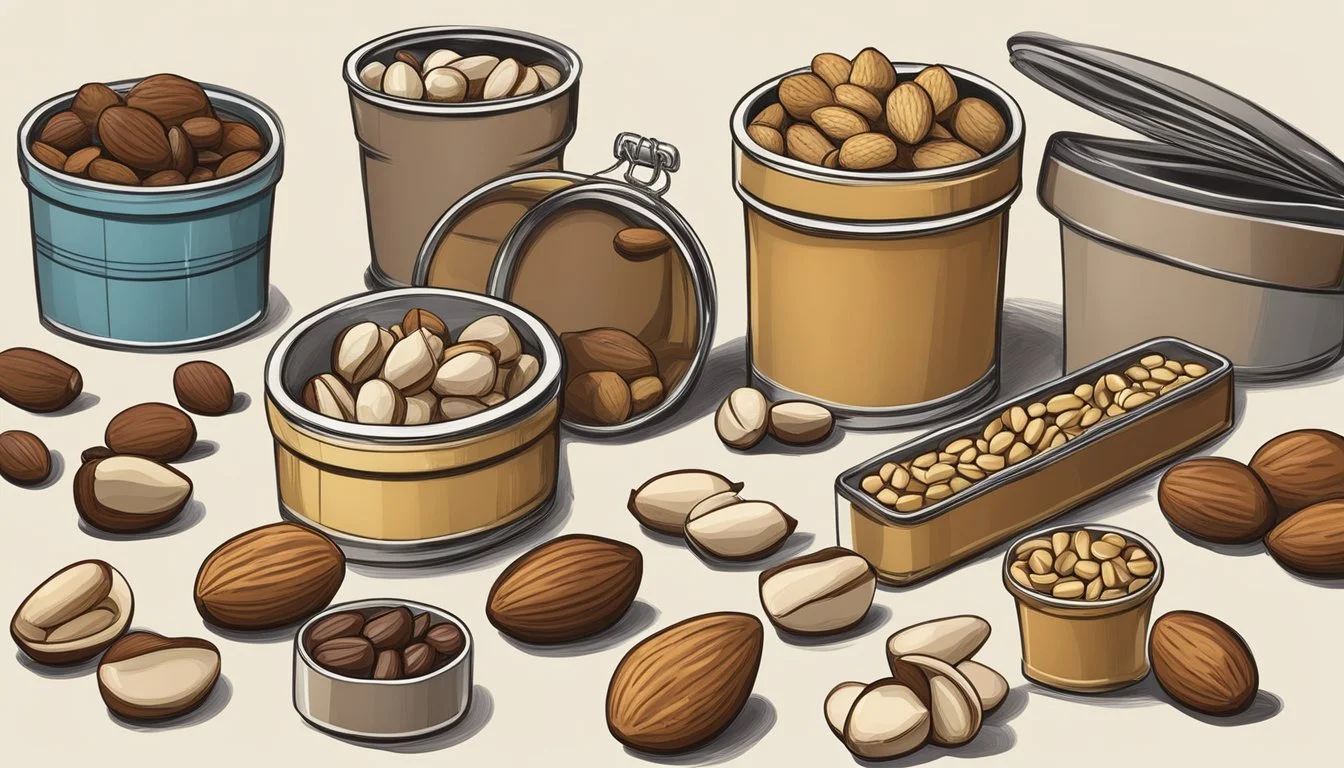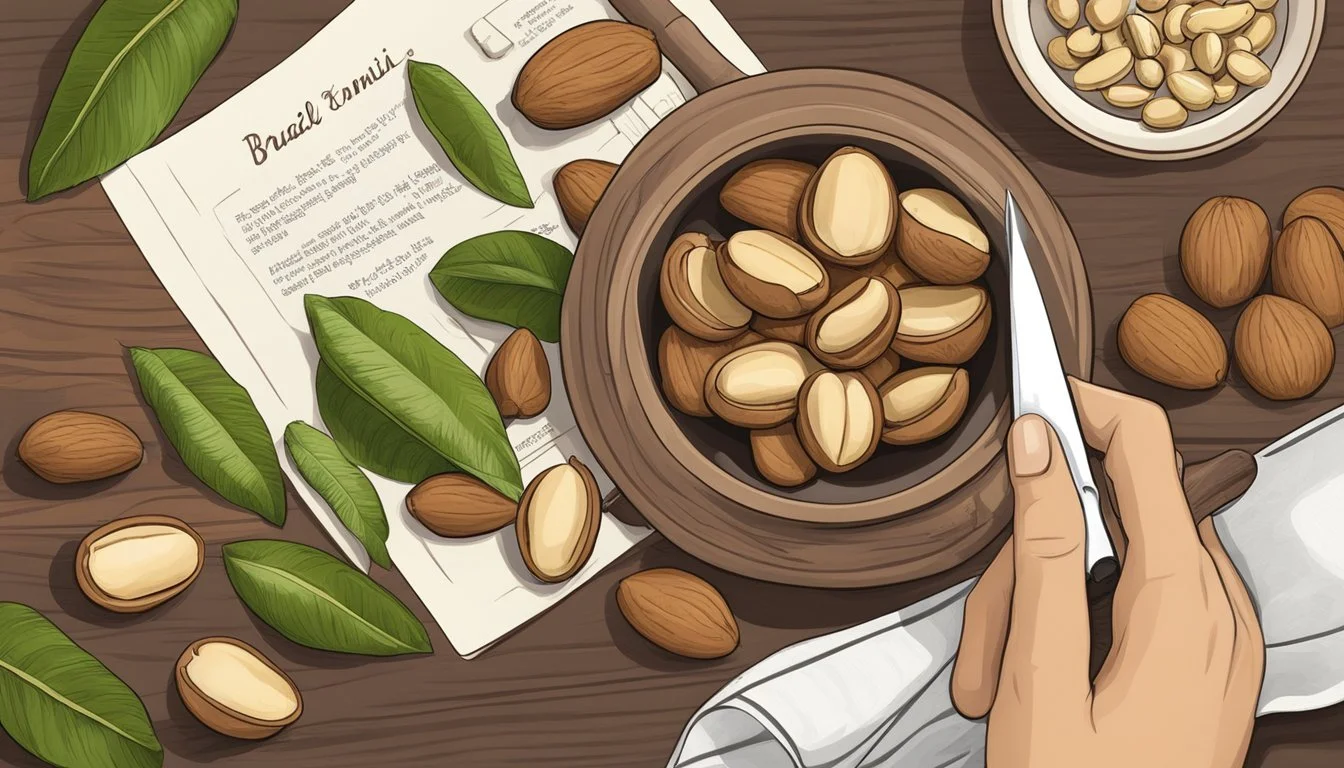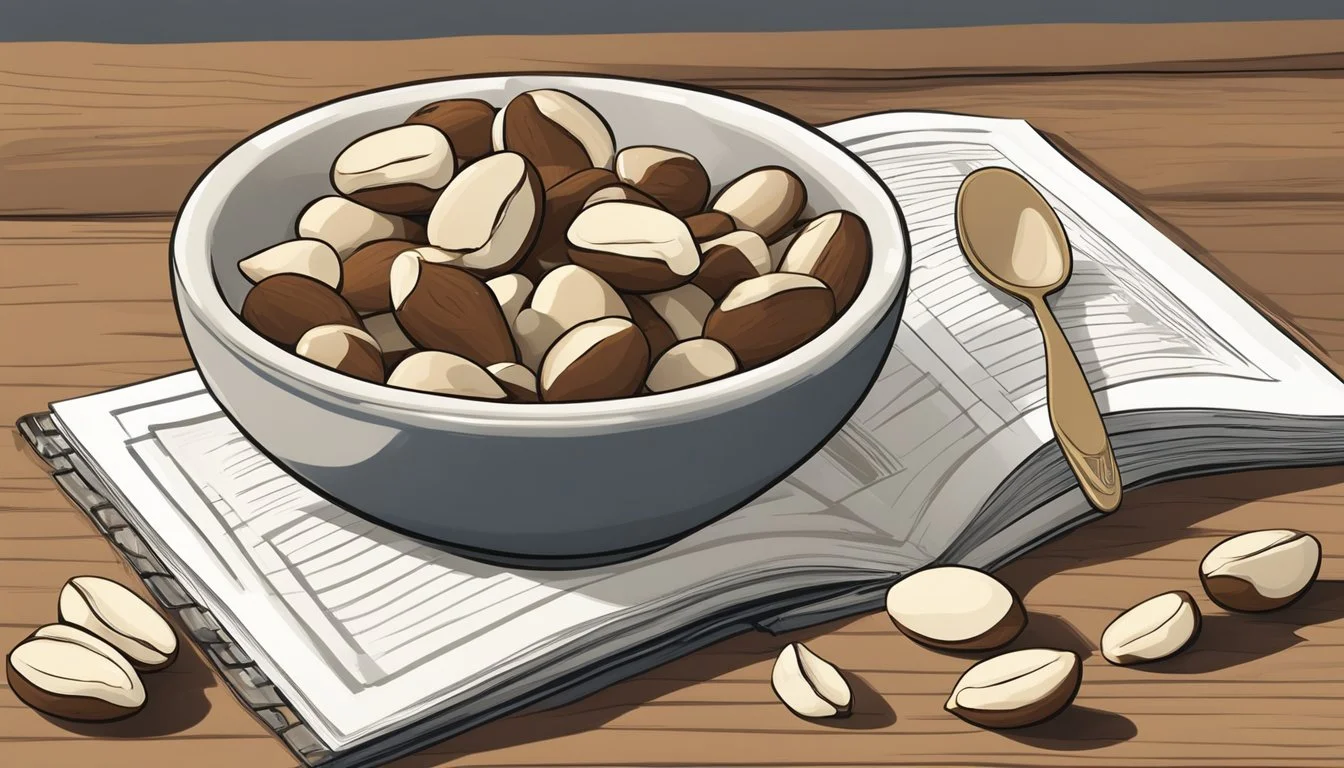How to Substitute Brazil Nuts for Macadamia Nuts
A Simple Swap Guide
When it comes to baking and cooking, nuts are a powerhouse ingredient that can transform the texture and flavor profile of a dish. Macadamia nuts, with their creamy texture and rich, buttery taste, are a favorite in many recipes. However, there are instances when these nuts may not be readily available or when individuals might have dietary restrictions or preferences that necessitate an alternative. Brazil nuts emerge as a suitable substitute in such situations, with their similar texture and nutritional profile.
Brazil nuts can successfully mimic the characteristics of macadamia nuts in various recipes. Their creamy consistency works particularly well in baked goods, contributing to a rich mouthfeel. While the flavor of Brazil nuts is distinct, it carries a certain richness that can approximate the luxurious quality of macadamia nuts. They are also a reasonable replacement based on their availability and cost-effectiveness compared to the often pricier macadamias.
Substituting Brazil nuts for macadamia nuts can be done with little to no adjustment in measurement in recipes, allowing for a seamless culinary swap. Both nuts can be chopped, ground, or used whole depending on the recipe's requirements. Cooks and bakers aiming to retain the original integrity of their dishes will find Brazil nuts to be an excellent alternative, capable of delivering the desired textural and flavor components that macadamias provide.
Understanding Nuts Profile
When substituting Brazil nuts for macadamia nuts, it’s important to consider their nutritional content, flavor profiles, and textures as these factors will influence the end product in culinary applications.
Nutritional Comparison
Macadamia nuts and Brazil nuts offer distinct nutritional benefits that are essential to understand. Macadamia nuts are known for their high fat content, with approximately 22 grams of fat per 1-ounce serving. In contrast, Brazil nuts have a slightly lower fat content with around 19 grams of fat per serving. Both nuts are good sources of healthy fats that can contribute to heart health. However, Brazil nuts offer a significant amount of selenium, a trace mineral that plays a critical role in metabolism and thyroid function. Here's a quick comparative breakdown:
Nutrient Macadamia Nuts (per 1 oz) Brazil Nuts (per 1 oz) Calories 204 186 Total Fat (g) 22 19 Protein (g) 2 4 Fiber (g) 2.4 2.1 Selenium (mcg) 1.2 544
Flavor Profiles
Both types of nuts have distinctive flavors which should be recognized when making substitutions. Whereas macadamia nuts have a subtle, buttery taste, Brazil nuts are characterized by their earthy, slightly bitter flavor. Even though their flavors do not perfectly match, in many recipes, the rich and creamy taste of Brazil nuts can stand in as an alternative, particularly in baked goods where their flavor can complement other ingredients.
Texture Comparison
The texture of a nut can affect the mouthfeel and sensory characteristics of a dish. Macadamia nuts possess a creamy texture that melds smoothly into recipes. In contrast, Brazil nuts have a denser, slightly crunchy texture. While the crunchiness of Brazil nuts can provide a different sensory experience, they can still be used as a substitute in recipes calling for macadamia nuts where texture variations can be accommodated, such as in pestos, cookies, or salads.
Substitution Basics
When replacing macadamia nuts with Brazil nuts, understanding the basics of substitution is essential for maintaining recipe integrity.
General Substitution Guidelines
One can generally substitute Brazil nuts for macadamia nuts in a one-to-one ratio. However, since macadamia nuts are often considered a more expensive nut, using Brazil nuts can be a cost-effective alternative. The substituting nut should complement the overall dish without overpowering other ingredients.
Proportion and Measurement
Proportional substitution is straightforward:
1 cup macadamia nuts = 1 cup Brazil nuts
Using precise measurements ensures consistency in recipes where the delicate balance of flavors is important. It is critical to measure replacements accurately to maintain the desired outcome.
Texture Adaptation
Brazil nuts have a similar consistency to macadamia nuts but are slightly firmer. When the nuts are to be used raw or in larger pieces, the texture difference may be noticeable. However, for baked goods or when nuts are ground, the texture of Brazil nuts can mimic that of macadamia nuts adequately.
Flavor Matching
While Brazil nuts are from the same family and share some flavor qualities with macadamia nuts, their taste profile is distinct. They are creamy with a more pronounced earthiness. For recipes that feature macadamia nuts for their sweet and subtle flavor, one should be aware that the stronger taste of Brazil nuts might slightly alter the end result.
Recipes and Cooking Techniques
When substituting Brazil nuts for macadamia nuts, it is essential to consider the textural and flavor differences to ensure the success of your recipes. Here are techniques to adapt your cooking and baking methods to cater to the replacement.
Baking with Substitutes
In baking, the richness of Brazil nuts can closely replicate the texture and taste of macadamia nuts. They perform exceptionally well in cookies and cakes, where their creamy texture can shine. A standard substitution is a 1:1 ratio by volume or weight. Here's how to proceed in different baked goods:
Cookies: Cream together butter and sugar as usual, then mix in finely chopped Brazil nuts just as you would macadamia nuts.
Pie: For a pie crust or filling that calls for macadamia nuts, use equal parts of finely chopped Brazil nuts. They deliver a similar crunch and butteriness.
Cooking Savory Dishes
For savory dishes, Brazil nuts integrate well as a substitute due to their hearty texture and slightly sweet profile. They can be used in:
Crusted proteins: Replace macadamia nuts with finely ground Brazil nuts for a nutty crust on fish or chicken.
Salads: Chop and sprinkle over salads for an extra crunch, matching well with vinaigrette-dressed greens or grains.
Dessert Recipes
Brazil nuts can effortlessly replace macadamia nuts in a variety of desserts. Here's how chefs can adapt:
Chocolate Treats: When making chocolate bark or truffles, chefs can fold in chopped Brazil nuts to add a similar buttery crunch that macadamia nuts offer.
Nut-based creams or pastes: Process Brazil nuts until creamy for fillings or as a base for desserts, maintaining the desired consistency that macadamia nuts provide.
Remember that Brazil nuts are larger than macadamia nuts, so they should be chopped accordingly to maintain the balance and texture of your dish.
Specialty Uses and Alternatives
Exploring alternatives to Brazil nuts for use in macadamia-centric recipes involves selecting nuts that provide a similar texture and flavor profile. This section discusses specific alternatives for macadamia nut butter, confectionery uses, and snack applications.
Macadamia Nut Butter Alternatives
When substituting macadamia nut butter, one can consider cashews or almonds which provide a creamy consistency and a subtle sweetness.
Cashews: Offer a smooth texture and mild flavor, well-suited for spreads.
Almonds: Yield a slightly grainier texture, but the inherent sweetness is comparable to macadamia nuts.
Nut Alternatives in Confectionery
In the realm of sweets, such as brittle or pesto, where macadamia nuts are integral, selecting an appropriate substitute is vital for texture and taste.
Pesto: For a twist on traditional pesto, alternatives like walnuts or pecans can be used to mirror the rich, buttery essence of macadamia nuts.
Macadamia Nut Replacement Notes on Texture and Flavor Walnuts Crunchier texture with a slight bitterness Pecans Buttery and rich, somewhat sweeter
Brittle: Candlenuts, usually harder to find, are a good alternative as well, and maintain the crunch expected in a nut brittle.
Salads and Healthy Snacks
Both flavor and texture are key when incorporating nuts into salads and snacks. Macadamia nuts offer a creamy and subtle sweetness that pairs well with an array of ingredients.
Salads: Sliced almonds or chopped cashews can be sprinkled into salads to emulate the macadamia nut's characteristics without overpowering the dish.
Nut Option Advantage in Salads Almonds Sliced almonds provide a satisfying crunch. Cashews Chopped cashews offer creaminess to the salad.
Snacks: Brazil nuts can be an alternative in trail mixes or as a standalone snack, offering a similar nutritional profile and a full-bodied flavor that can enrich any snack mix.
Nut Storage and Preservation
Proper storage of Brazil nuts ensures they maintain their quality and nutritional value. By following specific guidelines and methods to extend their shelf life, the nuts can remain a tasty and healthy addition to one's diet.
Storage Guidelines
One should store Brazil nuts in an airtight container to prevent exposure to moisture and other contaminants. For short-term storage, a cool, dry pantry is suitable, but for longevity, placing them in the refrigerator is recommended.
When storing in the refrigerator:
Ensure the nuts are in an airtight container or a resealable plastic bag.
Keep them away from strong-smelling foods as nuts can absorb odors.
Extending Shelf Life
To further extend the life of Brazil nuts:
Refrigeration is key, which can preserve their freshness for up to six months.
For storage beyond six months, freezing the nuts in airtight containers is an option, safeguarding their quality for up to a year.
When freezing, take note:
Label the container with the date of storage to track freshness.
Thaw nuts in the refrigerator overnight before use to maintain their texture and flavor.
Nutritional and Health Considerations
When substituting Brazil nuts for macadamia nuts, one should consider their distinct nutritional profiles and potential dietary restrictions. Selenium content and fat composition are notably different between the two, impacting their health benefits accordingly.
Allergies and Dietary Restrictions
Brazil nuts and macadamia nuts are both tree nuts, which are common allergens. Individuals with tree nut allergies should avoid both types of nuts, as they can trigger serious allergic reactions. For those following a vegan diet, both Brazil nuts and macadamia nuts are suitable choices, as they are plant-based sources of nutrients and fat.
Selenium: A single Brazil nut provides a substantial amount of selenium, often exceeding the daily requirement, while macadamia nuts offer considerably less.
Nutrients: Compared to macadamia nuts, Brazil nuts have a higher protein content and contain more micronutrients like magnesium and phosphorus.
Healthy Eating Tips
When incorporating nuts into the diet for their health benefits, it is essential to consider their nutrient composition.
Fat Composition: Macadamia nuts are high in monounsaturated fats, which are beneficial for heart health. Brazil nuts, while also containing monounsaturated fats, provide a balanced mix of both mono and polyunsaturated fats.
Portion Control: Due to the high fat content in both nuts, moderating portion sizes is crucial to prevent excessive calorie intake.
Selenium Toxicity: Overconsumption of Brazil nuts can lead to selenium toxicity. They should be eaten in moderation—no more than one to three Brazil nuts per day is generally advised to avoid surpassing the recommended daily intake of selenium.
By understanding these nutritional and health considerations, one can make an informed decision when substituting Brazil nuts for macadamia nuts in their diet.
Regional Nut Varieties
This section explores how geographical origins influence the characteristics and cultivation of macadamia nuts and Brazil nuts. Each type of nut has a rich history and distinct qualities shaped by the region it is grown in.
Australian Macadamias
Australian macadamias, colloquially known as Queensland nuts, are indigenous to northeastern Australia. They have been part of the Aboriginal diet for thousands of years and have a creamy texture and delicate flavor. The macadamia nut industry thrives in Australia, particularly in regions like Queensland and New South Wales. Macadamia integrifolia is the primary species grown in Australia, and the country is one of the largest producers of macadamia nuts globally.
Key Points:
Origin: Northeastern Australia
Historical Diet: Aboriginal ingestion
Primary Species: Macadamia integrifolia
Regions: Queensland, New South Wales
Global Status: Leading Producer
Brazil Nuts and South American Varieties
Brazil nuts are native to the Amazon rainforest and are harvested from the Bertholletia excelsa tree. South America, particularly Brazil, Bolivia, and Peru, is the main producer of these nuts, which are known for their rich selenium content and large size. Unlike Australian macadamias, Brazil nuts are rarely cultivated and are primarily collected from wild trees, making them an ecologically significant non-timber forest product.
Key Points:
Origin: Amazon rainforest
Harvesting: Wild collection from Bertholletia excelsa
Primary Producers: Brazil, Bolivia, Peru
Nutrient: Rich in selenium
Cultivation: Minimal, mostly wild-harvested
Affordability and Budgeting
When considering a substitution for macadamia nuts, budgeting is an essential factor for many individuals. Brazil nuts often emerge as a practical choice, as they tend to be more affordable. The prices of nuts can fluctuate based on factors such as seasonality, availability, and regional production costs. However, Brazil nuts are generally less expensive than macadamia nuts, thus offering a budget-friendly alternative.
Comparison of Nut Prices:
Nut Type Price Range (per lb) Macadamia Nuts High Brazil Nuts Moderate
For consumers who regularly incorporate nuts into their diet, the price difference can significantly impact their grocery budget. While macadamia nuts are known for their luxurious appeal and are often on the higher end of the price spectrum, Brazil nuts provide similar richness and texture at a more accessible price point.
When purchasing Brazil nuts in lieu of macadamia nuts, buyers should consider buying in bulk to further enhance savings, especially if they plan to use nuts frequently in their cooking and baking. Many health food stores and online retailers offer discounts for larger purchases. The key is to store them properly to maintain freshness.
Practical Tip: Purchase Brazil nuts with the shell intact to extend their shelf life and get more value for the money spent, as shelled nuts usually cost less.
In summary, using Brazil nuts as a substitute for macadamia nuts is a financially sound decision that does not significantly compromise the flavor and texture of dishes. It allows individuals to enjoy similar taste profiles and culinary results while adhering to a more restrained budget.
Culinary Innovations
In substituting Brazil nuts for macadamia nuts within the realms of cuisine, chefs leverage a range of alternative nuts and seeds to maintain the integrity of their dishes. Their creativity shines in fusion dishes and plant-based recipes.
Fusion Cuisine
Fusion cuisine presents an opportunity for chefs to seamlessly integrate Brazil nuts into various culinary traditions in place of macadamia nuts. Coconut and almonds may serve as a base in tropical and Asian-inspired dishes, while pistachios and hazelnuts can add a touch of elegance to Mediterranean recipes. When making pesto, one might use pistachio oil for its distinctive flavor while substituting Brazil nuts for the traditional pine nuts.
Substitutes in Asian Dishes:
Coconut: Adds sweetness and texture.
Almonds: Provides a contrasting crunch.
Mediterranean Influences:
Pistachios: Offer a rich, buttery taste.
Hazelnuts: Contribute a depth of flavor.
Vegan and Vegetarian Options
Chefs incorporate Brazil nuts into vegan and vegetarian dishes (What wine goes well with vegetarian dishes?) as a nutrient-dense substitute for macadamia nuts. Cashews are favored for their creamy consistency in dairy-free cheese and sauces, whereas pecans may be used in 'meaty' plant-based recipes due to their hearty texture. For a protein-packed addition to salads and vegan entrees, chefs might opt for a variety of seeds such as pumpkin or sunflower seeds.
Examples of Nut and Seed Use:
Cashews: Ideal for creating smooth textures in vegan cheese and creamy sauces.
Pecans: Mimic the meatiness in vegan burgers and meatballs.
Seeds: Add protein and crunch to salads and toppings.
Conveying Quality and Taste
When substituting Brazil nuts for macadamia nuts, it's vital to consider how texture and flavor will be affected to ensure the dish retains its intended quality and taste.
Discussing Creaminess and Crunch
Brazil nuts evoke a buttery creaminess that closely resembles macadamia nuts when roasted. The crunch factor, pivotal to providing textural contrast in recipes, differs slightly between the two nuts. Macadamias present a more delicate crunch compared to the sturdier bite of Brazil nuts. To achieve a texture akin to macadamias in baked goods, chefs recommend roasting Brazil nuts to enhance their inherent creaminess and to mellow the crunch.
Table 1: Texture Comparison
Nut Type Texture When Raw Texture When Roasted Macadamia Buttery, Soft Creamy, Crunchy Brazil Firm, Crunchy Enhanced Creaminess
Expressing Nutty Flavors in Dishes
The inherent nutty flavors contribute significantly to a dish's overall profile. Macadamia nuts offer a subtle, rich taste that complements both sweet and savory applications. Brazil nuts share this nuttiness, with a prominent earthy note that can add depth to a dish. Utilizing roasted Brazil nuts can intensify their flavor, making them a worthy stand-in for the characteristic roasted notes of macadamias in recipes.
List of Flavor Qualities
Macadamia Nuts: Subtly sweet, rich, buttery
Brazil Nuts: Earthy, slightly sweet, robust
Macadamia Nut Side Products
Macadamia nuts yield valuable by-products, notably macadamia nut oil, which is often compared to the moisturizing properties of cocoa butter. These side products have significant applications in various industries.
Oil Extractions
Macadamia nut oil is extracted from the nut’s meat and highly prized for its nutritional profile. It is rich in monounsaturated fats, resembling the health benefits of olive oil. Unlike cocoa butter, macadamia nut oil is lightweight and has a higher smoke point, making it suitable for both cooking and raw culinary applications.
Comparison Table: Macadamia Nut Oil vs. Cocoa Butter
Property Macadamia Nut Oil Cocoa Butter Fat Type Monounsaturated Saturated Smoke Point High (210°C/410°F) Medium (200°C/390°F) Flavor Mild, Nutty Rich, Chocolatey Texture Light, Non-Greasy Thick, Creamy Primary Use Cooking, Cosmetics Confectionery, Cosmetics
Cosmetic Uses
In the cosmetic industry, macadamia nut oil is used for its hydrating and reconstructive properties. It absorbs well into the skin without leaving a greasy residue, making it an excellent moisturizer akin to cocoa butter. Macadamia nut oil serves as a base for a variety of skin and hair care products due to its high fatty acid content and antioxidants, which promote healthy skin and hair.
Skincare: Utilized in lotions, creams, and balms for its hydrating effects.
Haircare: Added to shampoos and conditioners to strengthen and add a healthy shine.
Versatility: Suitable for all skin types, from dry to oily.
By providing nourishment and protection, macadamia nut oil holds a valuable position as a macadamia nut side product, compatible with the roles of cocoa butter in the cosmetic realm.
Baking Favorites and Treats
When baking treats such as white chocolate macadamia nut cookies, substituting Brazil nuts for macadamia nuts can offer a comparable richness and a delightful crunch. Here, the aim is to replicate the buttery flavor and creamy texture that makes macadamia nuts so popular in baked goods.
Substitute Ratio
For every 1 cup of macadamia nuts, use the same amount of chopped Brazil nuts (1 cup).
Texture and Flavor Adjustments
Brazil nuts tend to have a slightly more pronounced flavor compared to macadamias. Their texture is also firmer. When chopped and baked into cookies or other desserts, they blend nicely with sweet ingredients, complementing the overall flavor profile.
Additions for Enhanced Flavor
White Chocolate: Maintains the cookie's creamy sweetness.
Butterscotch Chips: Introduces a caramel-like undertone that pairs well with the Brazil nuts' natural taste.
Recipe Example
Ingredients:
- 1 cup Brazil nuts (chopped)
- 2 cups all-purpose flour
- 1/2 tsp baking soda
- 1/2 tsp salt
- 3/4 cup unsalted butter (melted)
- 1 cup packed brown sugar
- 1/2 cup white sugar
- 1 tbsp vanilla extract
- 1 egg
- 1 egg yolk
- 2 cups white chocolate chips
- 1/2 cup butterscotch chipsFollow typical cookie baking methods: cream together butter and sugars, add eggs and vanilla, mix in dry ingredients, then stir in Brazil nuts, white chocolate, and butterscotch chips. Bake until the edges are golden but the center remains soft. This recipe will yield cookies with a delightful combination of flavors and textures, paying homage to the original macadamia nut inclusion while introducing the distinctive qualities of Brazil nuts.
Handling and Processing Nuts
When substituting Brazil nuts for macadamia nuts, it is essential to understand proper handling and roasting techniques to achieve the desired flavor and texture in your recipes.
Roasting Procedures
Roasting nuts can dramatically enhance their flavor. Whether one opts for raw Brazil nuts or roasted pecans as a substitute, the roasting process is similar. They should first be spread on a baking sheet in a single layer to ensure even cooking.
Temperature: Preheat the oven to 350°F (175°C).
Time: Roast raw Brazil nuts for approximately 10-15 minutes and raw cashews for about 8-12 minutes, checking frequently to avoid burning.
Cooling: Allow the nuts to cool completely before using them to ensure they have reached their full crunchy texture.
Creating Homemade Nut Mixes
A mix of raw and roasted nuts provides varied textures and flavors. For effective homemade nut mixes:
Proportion: Combine equal parts roasted pecans, raw cashews, and Brazil nuts.
Seasoning: Lightly salt or spice the mix as desired after roasting, while nuts are still warm, to adhere seasonings better.
Taking these steps ensures that the nuts maintain their natural oils and flavors, yielding a product that complements a wide array of dishes that would typically feature macadamia nuts.














